Wales has a slogan that is something along the lines of “Wales has more castles per square mile than probably anywhere else in the world.” While they do use the “probably,” (to avoid a lawsuit I’m sure) I did manage to see four of them on a three day trip last week.
The trip began with a short (about two hour) train ride from Paddington to Cardiff Central last Wednesday evening to meet up with my wife who had already arrived to attend a conference. Our hotel, cleverly named “Sleeperz” could not have been any closer to the train line running into the station:
The hotel was actually very nice, and the location near the station is well-situated for walking around Cardiff. The windows were nearly soundproof, so the trains weren’t an issue and allowed me to see a wide variety of passenger trains that seemed to be far more eclectic than what you’d typically see in London.
I ventured to Cardiff Castle on my first full day in town. The first line of its Wikipedia entry summarises its history beautifully:
Cardiff Castle (Welsh: Castell Caerdydd) is a medieval castle and Victorian architecture Gothic revival mansion, transformed from a Norman keep erected over a Roman fort in Cardiff, the capital of Wales.
The Castle also has a small museum where a portion of the original Roman wall has been excavated, and there is a Welsh military museum in the basement. On the castle ground, the keep was (quite literally) the high point of my visit. It was once connected at high level to the outer wall, but when landscape architect Capability Brown was hired to re-plan the grounds approximatley 200 years ago he had many of the ancient structures on the site dismantled and had the moat around the keep filled in (it’s since been re-watered).
Moving indoors, the house at the Castle has seen the most drastic changes over the years. While Henry Holland made changes in the late 18th Centrury, it was the Third Marquess of Bute and his architect William Burges that reinvented it during the Victorian era. The lavish interiors have recently been restored to most of their original beauty. This tightly-cropped shot shows the ceiling in the “Arab Room,” which was often used as a guest bedroom:
For a more complete history of Cardiff Castle, there is an excellent archeological summary here, provided by Cardiff University.
I spent most of the rest of the day wandering around Cardiff. It’s hard to miss Millenium Stadium by Populous Architects (formerly HOK Sport)- it’s wedged between the Taff River and the city. I’d probably like the stadium more if it weren’t for the fading coloured panels that encircle it, it already looks dated. In any case, here it is poking out from behind a number of other buildings:
The rest of the day was a whirlwind tour of Victorian and Edwardian arcades:
Followed by a trip to Cardiff Bay:
While nearly every photo of the Millenium Centre (designed by Capita Architecture) shows only the enormous front facade with Welsh lettering cut out of metal panels above the entrance, I think it’s important to show the surroundings. The area surrounding the development at Cardiff Bay is pretty decrepit, and I question spending so much money building a shopping/culture/entertainment area when there are numerous underused older buildings standing literally across the street. The Millenium Centre is not impressive as Architecture, it’s poorly detailed and built from a cacophony of external material that come together awkwardly at the corners:
The back of the building is a sea of red brick and security devices:
The high security is owing to it’s location next door to the Senedd, the National Assembly for Wales (by Richard Rogers):
I’ll reserve judgment on this building for now. I am sure it looks better in nicer weather, and I didn’t get to go inside.
The following day, I traveled via train to nearby Caerphilly where I saw Caerphilly Castle:
That’s not the real Castle, it’s a model that stands across the moat from the “real” thing:
The word real is in quotes because much of the castle was built in the 1930s as part of an extremely ambitious restoration (reconstruction) process funded by several of the Marquesses of Bute- the same family behind the work done at Cardiff Castle. Replica siege engines have been built, and the Great Hall has been restored. Not only were demolished buildings at the Castle rebuilt, a large part of the town that had grown up around the Castle walls was torn down in order to re-water the moat in the mid 20th Century. The Castle was originally built in the 1200s, and is one of the largest in the UK. It’s an early example of a concentric castle- the combination of outer walls and lakes would have made the castle very difficult to approach.
The next day, my wife and ventured over to Swansea, an hour from Cardiff by train. The remnants of a castle site next to a fountain and central square which had a temporary merry-go-round set up:
Note the exceptionally hideous BT Tower that sits directly behind the castle. It appeared that some condos were under construction about four metres from the side of the ruins as well, but it was hard to tell whether they’d been stalled by the recession or not.
We also ventured to Mumbles by bus. Mumbles (don’t you love the name) was a Victorian seaside resort and has the requisite pier to prove it. Too bad they couldn’t install some Old-Timey wrought iron CCTV cameras:
Mumbles, in reality, has a history that stretches back far beyond the 1890s- the area has been inhabited for about 3,000 years. Neighbouring Oystermouth contains the ruins of a castle (aptly named Oystermouth Castle). We saw people in costumes running around inside and assumed they had broken in to play a role-playing game, but I later discovered that they were most likely rehearsing for one of the open air Shakespeare productions that take place inside during the summer.
I’ll leave you with a final image of “The Big Apple” in Mumbles, tragically damaged by a reckless driver (according to the bus driver who dropped us off there). It is supposedly under repair:
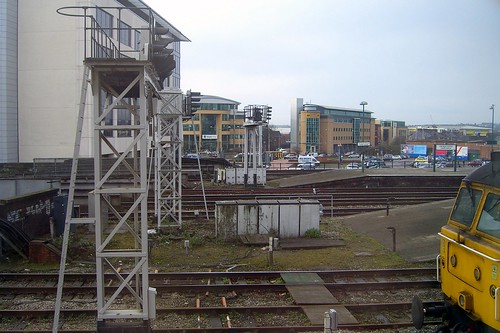
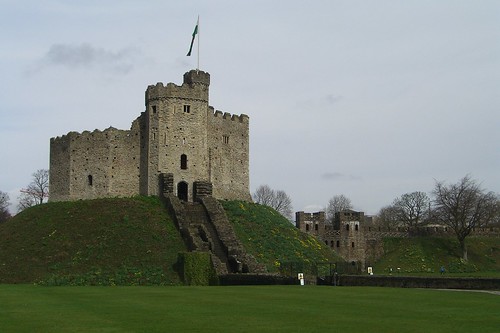

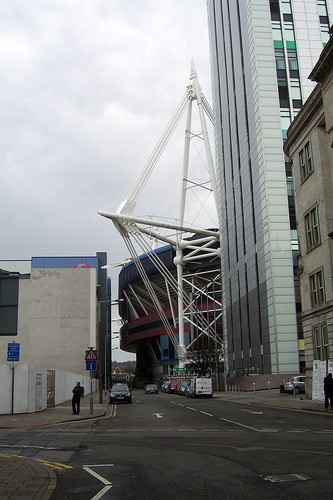
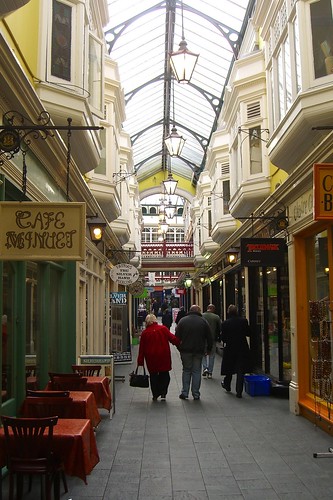
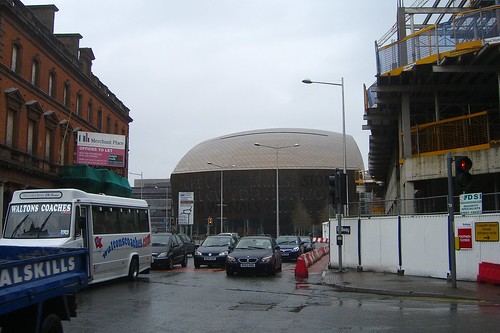
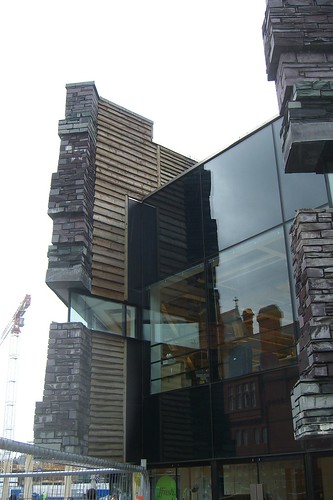
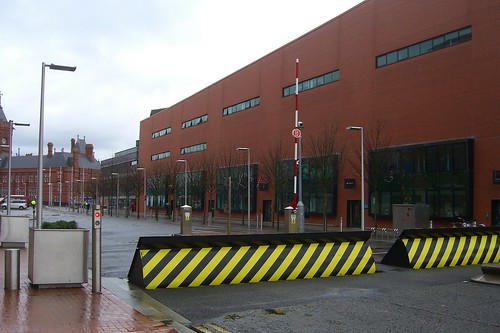


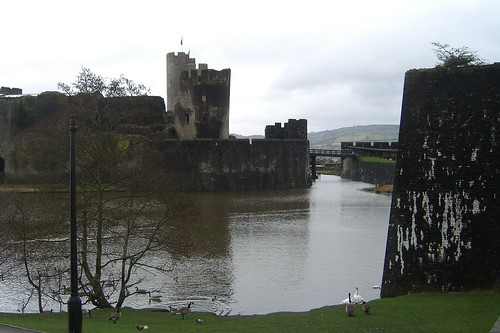
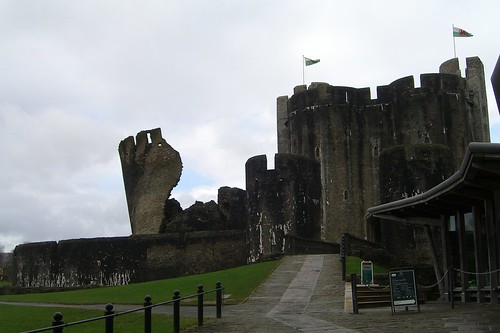
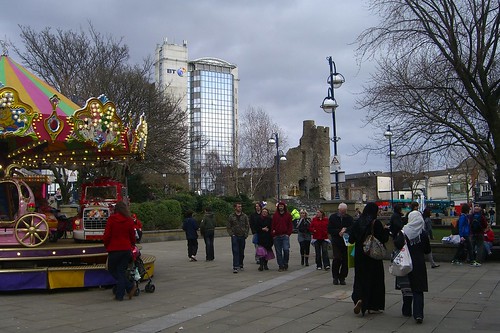
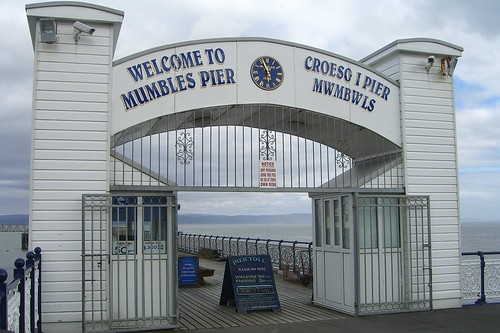

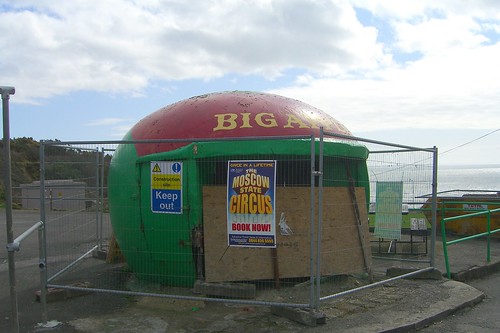
“I’m sure it looks better in nicer weather…” > not been to Wales before, then? That’s what the weather’s like every sodding day. I know, I spent 12 months in Cardiff. That was 13 years ago, the bay was a hideous facade fronting run-down council estates then, only looks to have got worse. Won’t be going back.
I wish I could have an opportunity to see and experience what I enjoy in the pictures and reading your blog